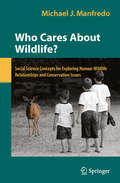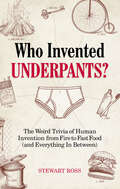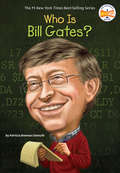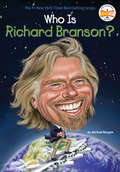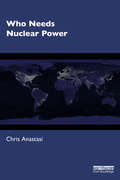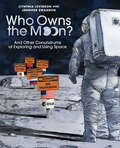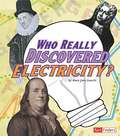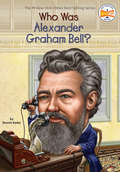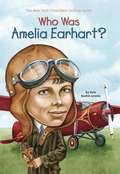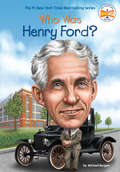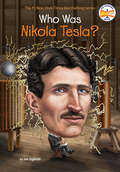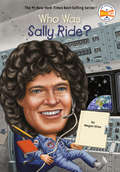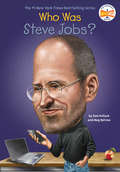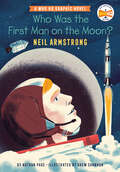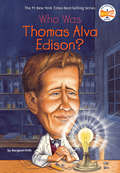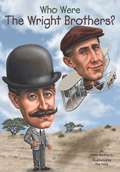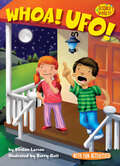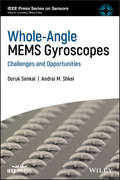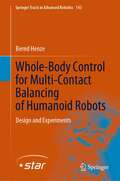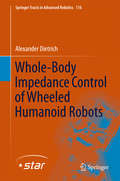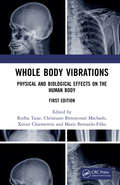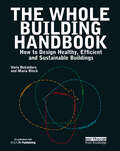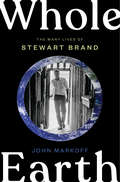- Table View
- List View
Who Cares About Wildlife?
by Michael J. ManfredoWho Cares About Wildlife? integrates social science theory in order to provide a conceptual structure for understanding and studying human interaction with wildlife. A thorough review of the current literature in conceptual areas, including norms, values, attitudes, emotions, wildlife value orientations, cultural change, and evolutionary forces/inherited tendencies is provided, and the importance of these areas in studying human-wildlife relationships is highlighted. No other book both considers the human relationship with wildlife and provides a theoretical framework for understanding this relationship on the individual, as well as cultural level. Who Cares About Wildlife? will be valuable both to students and to practitioners in wildlife management and conservation, as well those interested in the human relationship with wildlife, natural resources, and the environment.
Who Invented Underpants?: The Weird Trivia of Human Invention from Fire to Fast Food (and Everything In Between) (Fascinating Bathroom Readers)
by Stewart RossA comprehensive collection of fun facts about the origins of pretty much everything, from windows to washing machines to websites. This fact-packed collection recounts the origins, invention, and discovery of just about everything, from the big bang to driverless cars. With sections covering topics such as the arts, sports, weapons, buildings, medicine, food, and many more, you can find out intriguing answers to questions like:What material was the first clothing made out of?Who invented bathtubs?Who paved the first road?What came first: wine or whiskey?Perfect for history buffs, science lovers, or all-around trivia junkies, this entertaining and enlightening collection is for curious minds wondering about the mysteries of the beginning of all things.
Who Is Bill Gates? (Who was?)
by Nancy Harrison Patricia Brennan Demuth Ted HammondBill Gates, born in Seattle, Washington, in 1955, is an American business magnate, investor, philanthropist, and author. In this Who Was...? biography, children will learn of Gates' childhood passion for computer technology, which led him to revolutionize personal computers. Through the success of his now-world-famous software company, Microsoft, Bill Gates became one of the wealthiest philanthropists in history.This fascinating story of a child technology genius is sure to captivate all audiences!
Who Is Richard Branson? (Who Was?)
by Michael Burgan Ted HammondWhat would you do with a billion dollars? This question gets a definitive answer from billionaire Richard Branson: do everything! Born into a wealthy family in London, Branson suffered from dyslexia and was a poor student. Still, his knack for business started early with a successful parakeet-breeding enterprise at age 11.The charismatic entrepreneur launched his first major business, Virgin Records, at age 22 and spent the next few decades building the Virgin group that now includes more than 400 companies. Known for his eccentric lifestyle and trillion-watt smile, Branson's hot air balloon flights, innovative leadership, and world record attempts have made him an instantly-recognizable global icon.
Who Needs Nuclear Power
by Chris AnastasiWho Needs Nuclear Power challenges conventional thinking about the role of civil nuclear power in a rapidly changing energy context, where new energy carriers are penetrating markets around the world. Against the backdrop of a global energy transition and the defining issue of Climate Change, Chris Anastasi assesses new nuclear build in a fast-moving sector in which new technologies and practices are rapidly emerging. He considers various countries at different stages of nuclear industry development, and discusses their political, legal and technical institutions that provide the framework for both existing nuclear facilities and new build, as well as a country’s technical capability. He also highlights the critical issue of nuclear safety culture, exploring how organisations go about instilling it and maintaining it in their operations and encouraging it in their supply chains; the critical role played by independent regulators and international institutions in ensuring the integrity of the industry is also highlighted. This book provides a balanced and holistic view of nuclear power for both an expert and non-expert audience, and a realistic assessment of the potential for this technology over the critical period to 2050 and beyond.
Who Owns the Moon?: And Other Conundrums of Exploring and Using Space
by Cynthia Levinson Jennifer SwansonToday&’s teens may travel to the Moon in their lifetimes. This primer on what to know for a future in space combines technology and science with law and policy for a fascinating look at a very timely subject.For teens who are space fans, this book is loaded with fascinating facts, great stories, and new ways of thinking about the challenges of space. It covers topics on the science of space and developments in technology (e.g., satellites behaving like spacecraft), and it also considers the laws that have been drafted for space travel and space etiquette—the agreed upon norms of behavior that allow humans to explore without conflict.The book discusses the problem of space debris, and the growth of space tourism. It provides details about the Artemis missions and plans for the Gateway space station, and so much more. It challenges young readers to think about the decisions that need to be made in the years ahead to ensure that space exploration remains an exhilarating and peaceful activity.And the final chapter provides guidance on careers in the space industry—being an astronaut is only one of many exciting paths to pursue.A Junior Library Guild Gold Standard Selection
Who Really Discovered Electricity? (Race for History)
by Amie Jane LeavittFollows the stories of Dr. William Gilbert, Stephen Gray, and Benjamin Franklin as they explore the force now called electricity.
Who Really Killed Cock Robin? An Ecological Mystery
by Jean Craighead GeorgeEighth-grader Tony Isidoro follows a trail of environmental clues to try and figure out what ecological imbalances might have caused the death of the town's best-known robin.
Who Was Alexander Graham Bell?
by David Groff Bonnie BaderDid you know that Bell's amazing invention--the telephone--stemmed from his work on teaching the deaf? Both his mother and wife were deaf. Or, did you know that in later years he refused to have a telephone in his study? Bell's story will fascinate young readers interested in the early history of modern technology!
Who Was Amelia Earhart?
by Kate Boehm JeromeAmelia Earhart was a woman of many "firsts." In 1932, she became the first woman to fly solo across the Atlantic Ocean. In 1935, she also became the first woman to fly across the Pacific. From her early years to her mysterious 1937 disappearance while attempting a flight around the world, readers will find Amelia Earhart's life a fascinating story.
Who Was Henry Ford? (Who was?)
by Michael Burgan Nancy Harrison Ted HammondBorn on a small farm in rural Michigan, Henry Ford's humble beginnings were no match for his ambition. Ford quickly created a manufacturing dynasty, bringing affordable cars to the masses and forever changing America and the American workplace. Who Was Henry Ford? details his meteoric rise, and explains how the genius behind the assembly line and the Model T shaped modern American industry.
Who Was Neil Armstrong? (Who was?)
by Roberta Edwards Nancy Harrison Stephen MarchesiAvailable in time to commemorate the 40th anniversary of the Apollo 11 mission, this biography introduces youngsters to Neil Armstrong, the first man to step foot on the Moon. Illustrations.
Who Was Nikola Tesla? (Who Was?)
by Jim Gigliotti Who Hq John HinderliterGet ready for the electrifying biography of Nikola Tesla--part creative genius, part mad scientist, and 100% innovator. <P><P>When Nikola Tesla arrived in the United States in 1884, he didn't have much money, but he did have a letter of introduction to renowned inventor Thomas Edison. The working relationship between the two men was short lived, though, and the two scientist-inventors became harsh competitors. <P><P>One of the most influential scientists of all time, Nikola Tesla is celebrated for his experiments in electricity, X-rays, remote controls, and wireless communications. His invention of the Tesla coil was instrumental in the development of radio technology.
Who Was Sally Ride? (Who was?)
by Megan StineIn 1978, Sally Ride, a PhD candidate at Standford University, responded to a newspaper ad to join the US astronaut program. She was accepted and became the first American woman astronaut to fly in space! Among her other accomplishments, she played tennis like a professional, was an astrophysicist who helped develop a robotic arm for space shuttles, and later, through Sally Ride Science, worked to make science cool and accessible for girls. Sally Ride, who died on July 23, 2012, will continue to inspire young children.
Who Was Steve Jobs? (Who was?)
by Pam Pollack Meg BelvisoSteve Jobs, adopted in infancy by a family in San Francisco, packed a lot of life into fifty-six short years. In this Who Was#133;? biography, children will learn how his obsession with computers and technology at an early age led him to co-found and run Apple, in addition to turning Pixar into a ground-breaking animation studio. A college dropout, Jobs took unconventional steps in his path to success and inspired the best and the brightest to come with him and #147;change the world. ”
Who Was the First Man on the Moon?: A Who HQ Graphic Novel (Who HQ Graphic Novels)
by Nathan Page Who HQDiscover the story behind Neil Armstrong and the Apollo 11 mission in this immersive graphic novel -- by Montague Twins creative duo Nathan Page and Drew Shannon.Presenting Who HQ Graphic Novels: an exciting new addition to the #1 New York Times Best-Selling Who Was? series! From his childhood experiments to his first encounters with flight, explore the steps Neil Armstrong took in order to become the first person to land on the moon. A story of calculated risk, perseverance, and earth-defying reward, this graphic novel invites readers to immerse themselves in the life of the famous astronaut -- brought to life by gripping narrative and vivid full-color illustrations that fly off the page.
Who Was Thomas Alva Edison? (Who was?)
by John O'Brien Margaret Frith Nancy HarrisonOne day in 1882, Thomas Edison flipped a switch that lit up lower Manhattan with incandescent light and changed the way people live ever after. The electric light bulb was only one of thousands of Edison's inventions, which include the phonograph and the kinetoscope, an early precursor to the movie camera. As a boy, observing a robin catch a worm and then take flight, he fed a playmate a mixture of worms and water to see if she could fly! Here's an accessible, appealing biography with 100 black-and-white illustrations.
Who Were the Wright Brothers? (Who Was?)
by Nancy Harrison James Buckley Tim FoleyAs young boys, Orville and Wilbur Wright loved all things mechanical. As young men, they gained invaluable skills essential for their success by working with printing presses, bicycles, motors, and any sort of machinery they could get their hands on. As adults, the brothers worked together to invent, build, and fly the world's first successful airplane. This is the fascinating story of the two inventors and aviation pioneers who never lost sight of their dream: to fly, and to soar higher!
Whoa! UFO! (Science Solves It!)
by Kirsten LarsenIt's an unidentified flying object! And it's streaking across the night sky. Billy and Kara just have to find out - is it really a visitor from outer space?
Whole-Angle MEMS Gyroscopes: Challenges and Opportunities (IEEE Press Series on Sensors)
by Doruk Senkal Andrei M. ShkelPresents the mathematical framework, technical language, and control systems know-how needed to design, develop, and instrument micro-scale whole-angle gyroscopes This comprehensive reference covers the technical fundamentals, mathematical framework, and common control strategies for degenerate mode gyroscopes, which are used in high-precision navigation applications. It explores various energy loss mechanisms and the effect of structural imperfections, along with requirements for continuous rate integrating gyroscope operation. It also provides information on the fabrication of MEMS whole-angle gyroscopes and the best methods of sustaining oscillations. Whole-Angle Gyroscopes: Challenges and Opportunities begins with a brief overview of the two main types of Coriolis Vibratory Gyroscopes (CVGs): non-degenerate mode gyroscopes and degenerate mode gyroscopes. It then introduces readers to the Foucault Pendulum analogy and a review of MEMS whole angle mode gyroscope development. Chapters cover: dynamics of whole-angle coriolis vibratory gyroscopes; fabrication of whole-angle coriolis vibratory gyroscopes; energy loss mechanisms of coriolis vibratory gyroscopes; and control strategies for whole-angle coriolis vibratory gyro- scopes. The book finishes with a chapter on conventionally machined micro-machined gyroscopes, followed by one on micro-wineglass gyroscopes. In addition, the book: Lowers barrier to entry for aspiring scientists and engineers by providing a solid understanding of the fundamentals and control strategies of degenerate mode gyroscopes Organizes mode-matched mechanical gyroscopes based on three classifications: wine-glass, ring/disk, and mass spring mechanical elements Includes case studies on conventionally micro-machined and 3-D micro-machined gyroscopes Whole-Angle Gyroscopes is an ideal book for researchers, scientists, engineers, and college/graduate students involved in the technology. It will also be of great benefit to engineers in control systems, MEMS production, electronics, and semi-conductors who work with inertial sensors.
Whole-Body Control for Multi-Contact Balancing of Humanoid Robots: Design and Experiments (Springer Tracts in Advanced Robotics #143)
by Bernd HenzeThis book aims at providing algorithms for balance control of legged, torque-controlled humanoid robots. A humanoid robot normally uses the feet for locomotion. This paradigm is extended by addressing the challenge of multi-contact balancing, which allows a humanoid robot to exploit an arbitrary number of contacts for support. Using multiple contacts increases the size of the support polygon, which in turn leads to an increased robustness of the stance and to an increased kinematic workspace of the robot. Both are important features for facilitating a transition of humanoid robots from research laboratories to real-world applications, where they are confronted with multiple challenging scenarios, such as climbing stairs and ladders, traversing debris, handling heavy loads, or working in confined spaces. The distribution of forces and torques among the multiple contacts is a challenging aspect of the problem, which arises from the closed kinematic chain given by the robot and its environment.
Whole-Body Impedance Control of Wheeled Humanoid Robots
by Alexander DietrichIntroducing mobile humanoid robots into human environments requires the systems to physically interact and execute multiple concurrent tasks. The monograph at hand presents a whole-body torque controller for dexterous and safe robotic manipulation. This control approach enables a mobile humanoid robot to simultaneously meet several control objectives with different pre-defined levels of priority, while providing the skills for compliant physical contacts with humans and the environment. After a general introduction into the topic of whole-body control, several essential reactive tasks are developed to extend the repertoire of robotic control objectives. Additionally, the classical Cartesian impedance is extended to the case of mobile robots. All of these tasks are then combined and integrated into an overall, priority-based control law. Besides the experimental validation of the approach, the formal proof of asymptotic stability for this hierarchical controller is presented. By interconnecting the whole-body controller with an artificial intelligence, the immense potential of the integrated approach for complex real-world applications is shown. Several typical household chores, such as autonomously wiping a window or sweeping the floor with a broom, are successfully performed on the mobile humanoid robot Rollin' Justin of the German Aerospace Center (DLR). The results suggest the presented controller for a large variety of fields of application such as service robotics, human-robot cooperation in industry, telepresence in medical applications, space robotics scenarios, and the operation of mobile robots in dangerous and hazardous environments.
Whole Body Vibrations: Physical and Biological Effects on the Human Body
by Redha Taiar Christiano Bittencourt Machado Xavier Chiementin Mario Bernardo-FilhoWhole Body Vibrations: Physical and Biological Effects on the Human Body allows an understanding about the qualities and disadvantages of vibration exposure on the human body with a biomechanical and medical perspective. It offers a comprehensive range of principles, methods, techniques and tools to provide the reader with a clear knowledge of the impact of vibration on human tissues and physiological processes. The text considers physical, mechanical and biomechanical aspects and it is illustrated by key application domains such as sports and medicine. Consisting of 11 chapters in total, the first three chapters provide useful tools for measuring, generating, simulating and processing vibration signals. The following seven chapters are applications in different fields of expertise, from performance to health, with localized or global effects. Since unfortunately there are undesirable effects from the exposure to mechanical vibrations, a final chapter is dedicated to this issue. Engineers, researchers and students from biomedical engineering and health sciences, as well as industrial professionals can profit from this compendium of knowledge about mechanical vibration applied to the human body. Provides biomechanical and medical perspectives to understanding the qualities and disadvantages of vibration exposure on the human body Offers a range of principles, methods, techniques, and tools to evaluate the impact of vibration on human tissues and physiological processes Explores mechanical vibration techniques used to improve human performance Discusses the strong association between health and human well-being Explores physical, mechanical, and biomechanical aspects of vibration exposure in domains such as sports and medicine
The Whole Building Handbook: How to Design Healthy, Efficient and Sustainable Buildings
by Maria Block Varis BokaldersThe Whole Building Handbook is a compendium of all the issues and strategies that architects need to understand to design and construct sustainable buildings for a sustainable society. The authors move beyond the current definition of sustainability in architecture, which tends to focus on energy-efficiency, to include guidance for architecture that promotes social cohesion, personal health, renewable energy sources, water and waste recycling systems, permaculture, energy conservation - and crucially, buildings in relation to their place. The authors offer a holistic approach to sustainable architecture and authoritative technical advice, on: * How to design and construct healthy buildings, through choosing suitable materials, healthy service systems, and designing a healthy and comfortable indoor climate, including solutions for avoiding problems with moisture, radon and noise as well as how to facilitate cleaning and maintenance. * How to design and construct buildings that use resources efficiently, where heating and cooling needs and electricity use is minimized and water-saving technologies and garbage recycling technologies are used. * How to 'close' organic waste, sewage, heat and energy cycles. For example, how to design a sewage system that recycles nutrients. * Includes a section on adaptation of buildings to local conditions, looking at how a site must be studied with respect to nature, climate and community structure as well as human activities. The result is a comprehensive, thoroughly illustrated and carefully structured textbook and reference.
Whole Earth: The Many Lives of Stewart Brand
by John MarkoffTold by one of our greatest chroniclers of technology and society, the definitive biography of iconic serial visionary Stewart Brand, from the Merry Pranksters and the generation-defining Whole Earth Catalog to the marriage of environmental consciousness and hacker capitalism and the rise of a new planetary culture—the story behind so many other storiesStewart Brand has long been famous if you know who he is, but for many people outside the counterculture, early computing, or the environmental movement, he is perhaps best known for his famous mantra &“Stay Hungry. Stay Foolish.&” Steve Jobs&’s endorsement of these words as his code to live by is fitting; Brand has played many roles, but one of the most important is as a model for how to live. The contradictions are striking: A blond-haired WASP with a modest family inheritance, Brand went to Exeter and Stanford and was an army veteran, but in California in the 1960s he became an artist and a photographer in the thick of the LSD revolution. While tripping on acid on the roof of his building, he envisioned how valuable it would be for humans to see a photograph of the planet they shared from space, an image that in the end landed on the cover of his Whole Earth Catalog, the defining publication of the counterculture. He married a Native American woman and was committed to protecting indigenous culture, which connected to a broader environmentalist mission that has been a through line of his life. At the same time, he has outraged purists because of his pragmatic embrace of useful technologies, including nuclear power, in the fight against climate change. The famous tagline promise of his catalog was &“Access to Tools&”; with rare exceptions he rejected politics for a focus on direct power. It was no wonder, then, that he was early to the promise of the computer revolution and helped define it for the wider world. Brand's life can be hard to fit onto one screen. John Markoff, also a great chronicler of tech culture, has done something extraordinary in unfolding the rich, twisting story of Brand&’s life against its proper landscape. As Markoff makes marvelously clear, the streams of individualism, respect for science, environmentalism, and Eastern and indigenous thought that flow through Brand&’s entire life form a powerful gestalt, a California state of mind that has a hegemonic power to this day. His way of thinking embraces a true planetary consciousness that may be the best hope we humans collectively have.
